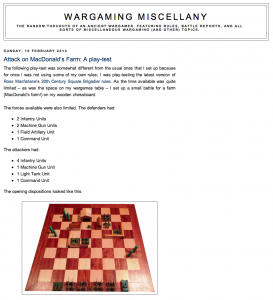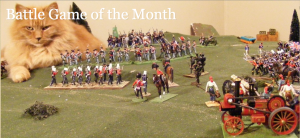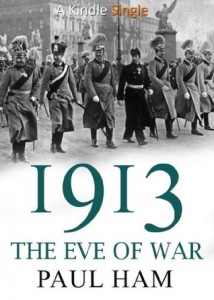From 1966…
GRAND DUCHY OF HESSE-DARMSTADT IN THE NAPOLEONIC WARS
by David Rusk
Table Top Talk, 1966
Hesse—Darmstadt troops served with the French from 1806-13, and then fought on the side of the Coalition against France. Until 1809, the army was a copy of the 1806 Prussian Army, but then it changed to the French system.
Organization
At first, there were three brigades, each with two line battalions and a fusilier (light) battalion. In 1809 the Erbprinz went to Spain, and converted its fusilier companies into two grenadier and two voltigeur companies, giving it a French six—company organization. The other two brigades kept their fusiliers until 1812, when the fusilier battalions were combined into a Garde Fusilier Regiment. This made three regiments, each with two battalions of four regular companies (the Garde Fusilier had four Fusilier companies per battalion).
Uniforms
The infantry wore dark blue coats and pants, white cross belts, brown knapsacks, dark blue coat rolls, and black shoes. The pants were usually worn over the gaiters. The Fusilier battalions of each brigade (until 1812) wore dark green uniforms with black cross belts.
All units wore black shakos with a silver shield and a white cockade with a red center. The shako had a double pompom with a red top and the bottom colored by company. Company colors were; first battalion, first company – white, second company – black, third company – blue, fourth company -red; second battalion, fifth company – yellow/white, sixth company – black/red, seventh company blue/white, and eight company red/white.
Facings
The Leibgarde Regiment had red plastron, collar, cuffs, turnbacks, and pants stripes. It also had dark blue cuff tabs, edge red, and dark blue epaulettes, without fringes and edged red also.
The Leibgarde plastron, worn for parade or full dress battle, had two rows of short white lace strips down each side (seven strips per row) and seven white buttons down the middle. The cuff tabs had three laces and three buttons. The attached Fusilier battalion, until 1812, had the same facings on its dark green uniform.
The Leib Regiment used medium blue facings with the same uniform.
The Erbprinz Regiment had yellow facings. It also wore medium brown pants. Grenadiers had red plumes, cords and epaulettes. Voltigeurs had green cords, plumes tipped yellow, and green epaulettes with yellow half-moons.
The Garde Fusilier Regiment was the same as the Leibgarde, but with scarlet facings.
Cavalry
The Guard Chevauleger Regiment wore a dark green uniform. It had a red collar with black side patches, black cuffs and plastron. Six short white lace strips were on each side of the plastron, with a white button toward the outside edge of each strip. Three V—shaped laces with a white button in the center, reaching from wrist to elbow, were on the coat sleeves. The red shoulder boards were trimmed white, while the pants had red stripes. The waistbelt was white, while the shoulder belt was black and worn over the left shoulder. Boots, helmet with short crest and plume, were all black. Sabraque was dark green, trimmed with a black-white-black edge.
For Scruby Miniatures in 30mm see figure listing on the HistoriFigs website.




